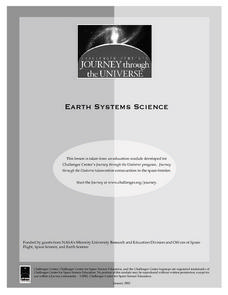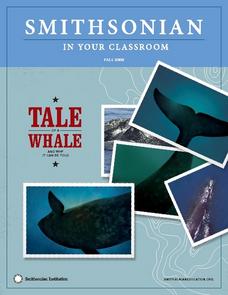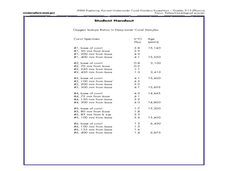Curated OER
Sailors and Sharks
Young scholars use the skills of fleeing and dodging in order to avoid being tagged. They begin standing on the ships (mats). One student, the shark, wears a pinney. At the signal from the teacher of "Sailors swim", the sailors scatter...
Curated OER
Christopher Columbus
Students read about the good and bad aspects of Christopher Columbus in Jean Fritz's book, "Where do you think you're going, Christopher Columbus?" They conduct and analyze a survey about common myths and create a pop-up book.
Curated OER
Myth-try Cards Activity
Students read creation myths to learn various cultural explanations for natural phenomena. They select sharks and write myths to explain physical structures, behaviors or roles in ecosystems. They research the animals to provide...
Curated OER
Habitats and Adaptations
Young scholars research and describe the habitat and adaptations of a reef animal. After the student is assigned a habitat, they design and draw a cresture adapted to eat each food and to live in each habitat.
Curated OER
Dig Into Ireland
Students explore environments and wildlife of Ireland to find out how they were formed, and how they helped form Irish culture. Students research online to determine connections between present elements in Irish culture and wildlife and...
Curated OER
Temperature Affects The Heart Rate
Students relate heart rate and development to environmental conditions through experiment. In cooperative groups, students record the heart rate in developing zebra fish. Groups create a standard curve to predict the temperature at...
Curated OER
Rust Never Sleeps
Students investigate oxidation-reduction reactions involving iron by conducting an experiment in which they expose iron filings to different atmospheric and ocean conditions. They relate the results to the oxidation banding patterns seen...
Curated OER
The Mission of Lewis and Clark
Students comprehend the various aspects of the Lewis and Clark expediton. They complete an idea web. Students work in small groups. They recall some important aspects of the Lewis and Clark expedition by performing the Corps of...
Curated OER
A Tale of a Whale: And Why It Can Be Told
Students examine the characteristics of particular whales. In this whale characteristics lesson, students discover the methods scientists use to track whales and attempt to match the unique pattern of callosities themselves. A role...
Curated OER
Deep Gardens
Learners compare and contrast deep-sea coral reefs with shallow-water coral reefs. In this underwater ecology lesson, students describe three types of coral and explain why scientists are concerned about the future of deep-sea coral.
Curated OER
What's Down There
High schoolers write an essay about the coral reefs. In this oceanography instructional activity, students investigate the reef of Bonaire and compare it to reefs that are not thriving. High schoolers then explore the differences that...
Curated OER
Is the Hudson River Too Salty to Drink?
Students explore reasons for varied salinity in bodies of water. For this geographical inquiry lesson, students use a variety of visual and written information including maps, data tables, and graphs, to form a hypothesis as to why the...
Curated OER
Tracking a Hurricane
Students play the role of amateur meteorologists and track a hurricane. In this hurricane instructional activity, learners follow a hurricane by tracking its coordinates on an overhead map. Students work in small groups to place dots on...
Curated OER
Internet Field Trip: Simple Machines
Students research simple machines. In this physics instructional activity, students participate in a WebQuest to gain knowledge about simple machines. WebQuest activities and worksheets are included in this instructional activity.
Curated OER
Ancient Bugs
High schoolers describe Archaea. In this biology lesson, students examine biological communities and the role Archaea plays. High schoolers will compare and contrast the Archaea with bacteria and eukaryote.
Curated OER
Architects of the Coral Reef
Students discuss reproduction in Cnidaria. in this coral reef lesson, students describe five characteristics of Cnidaria and compare and contrast the four classes. They describe the reproduction strategies they use.
Curated OER
How do living and non-living structures affect coral reef habitats?
Students create model coral reefs showing surface area and including examples of communities. In this coral reef lesson, students research and explore the functions or benefits from a coral reef. Students design a benthic...
Curated OER
How can deep-water corals be used to determine long-term patterns of climate change?
Students explore the concept of paleoclimatological proxies. In this paleoclimatological proxies lesson, students explain isotope ratios in deep water coral samples. Students write a paragraph about global climate change as...
Curated OER
Climate Change: Is there a Controversy
Students explore climate changes. In this climate changes lesson, students research what causes changes. Students search the Internet, summarize reports they find and create a poster with the information.
Curated OER
The Middle Passage
Eighth graders locate the Middle passage and describe the experiences of slaves in the Middle Passage. In this Middle Passage lesson, 8th graders describe life as a slave during the Middle Passage. Students write as if they...
Curated OER
Is This a House for Hermit Crab?
First graders identify text that uses sequence or other logical order. They identify and interpret how different plants and animals inhabit different kinds of environments and have external features that help them thrive in different...
Curated OER
Frozen Seas
Students research animal life in the frozen seas. In this researched based lesson, students use the Internet to create a poster about an animal that lives in an Arctic or Antarctic environment. Students will focus on the behavioral and...
Curated OER
Readers Who Struggle Can Learn From Wonderful Teacher/Student Created On-Level Reading Projects
Learners create their own books. In this book making lesson, students pick a subject and take photographs of it. They use these photographs to write their own story using their sight words.
Curated OER
Compass Building Instructions
Students build their own compass following a given procedure. In this technology lesson, students explain how a compass is used in navigation. They trace the history of its development.

























